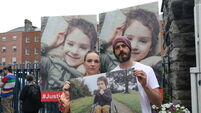Urgent need to reform libel laws
Given the gravity of Ian Bailey’s claim that he had been branded a murderer by the press, the outcome of his libel case is a resounding vindication of the media’s role in covering the appalling murder of French film maker Sophie Toscan du Plantier near Schull in West Cork just two days before Christmas seven years ago, a crime that remains unsolved to this day.
Paltry and derisory are perhaps the words that best describe damages awarded to the freelance journalist in his libel action against seven Irish and British media groups.
Public interest has been intense in this case, which arose out of coverage in the wake of Mr Bailey’s arrest by gardaí for questioning about the murder. Though a prime suspect, he was never charged and was seeking a maximum €266,000 for alleged damage to his reputation.
Critically, in his landmark verdict, Circuit Court Judge Patrick Moran has ruled in favour of the media on central issues. Primarily, he found the claimant had not been branded a killer and that the coverage of five newspapers was not defamatory of Ian Bailey.
However, damages of €4,000 each were awarded against two British newspapers, The Mirror and The Sun, which defamed Mr Bailey by failing to stand over reports claiming he had been violent towards his ex-wife. This may prove crucial when the judge apportions legal costs of around €650,000, possibly ordering the British papers to pick up the bill.
Ironically, evidence of serious assaults by Mr Bailey against his present partner was accepted by the court.
While this was not a murder trial, the outcome leaves many questions unanswered. Significantly, Judge Moran concluded the media were justified in describing Ian Bailey as a violent man.
From his experience in family law, the judge said it was exceptional to come across one instance of violence against a partner. But it was extremely exceptional to come across two such cases and beyond belief to come across three.
The judge also found inconsistencies between the evidence of 21 witnesses and Mr Bailey’s version of events. Critically, on his claim of never having met the murdered woman, the judge accepted the word of Alfie Lyons, her neighbour, who was 80-90% sure he had introduced her to Mr Bailey.
He also accepted the account of Mrs Marie Farrell, who said she saw the claimant in the early hours of the morning in a dishevelled state on a bridge about one-and-a-half miles from the murder scene. This despite Ian Bailey’s denial that he had left his house on the night in question.
The judge also accepted the evidence of 14-year-old Malachi Reid, who said Mr Bailey told him he had “gone up there with a rock and bashed her brains in.”
Failure to solve the murder highlights the urgent need for government to ensure that scientific examination of murder scenes are never again held up because of lack of adequate resources for the vital work of the State Pathologist and the State Laboratory.
On balance, it was a good judgment for the media and highlights the grave need to reform the libel laws.
But the issue is far from closed as unique proceedings are now being initiated in the High Court by the parents of Sophie Toscan du Plantier, seeking damages from Ian Bailey over her death in a murder that remains unsolved.
















